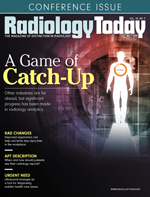 MRI Monitor: Quick Take
MRI Monitor: Quick Take
By Dave Yeager
Radiology Today
Vol. 20 No. 7 P. 5
MRI is an important tool for diagnosis and research, but one of its drawbacks is long scan times, which can make it difficult to get necessary views and cause scheduling bottlenecks. To reduce MR scanning time, researchers and vendors are developing methods to acquire essential information in less time. One such company is SyntheticMR, which has developed a brain protocol that can be performed in approximately six minutes. The company’s software, called SyMRI, recently received FDA clearance for clinical use.
“Our approach is really to have a certain scan time with enough signal-to-noise ratio that it produces clinically viable images with the ability to look at different contrasts and be very flexible in the weighting that you’re looking at,” says Marcel Warntjes, PhD, chief technology officer and founder of SyntheticMR.
Objective Diagnostic Support
SyMRI can synthetically create eight different contrast-weighted images such as T1, T2, and fluid-attenuated inversion recovery (FLAIR). The images are captured with a multislice approach that generates approximately 30 slices. In addition, the software creates parametric maps of relaxation values for T1, T2, and proton density (PD) views. It also provides automatic tissue segmentation and volumetric measurements for white matter, gray matter, and cerebrospinal fluid. Adjustable contrast images are synthesized from quantitative data. Postprocessing takes 10 seconds. Warntjes says the software allows radiologists to get clinical data in significantly less time than a typical scan.
“We have a sequence that takes six minutes and maybe less; there are some people who run them in four-and-a-half minutes, but what we aim for is to get a lot of information in a short amount of time,” he says. “And, since you have to prepare the patient anyway, it doesn’t make any sense to have a 30-second scan. You would typically aim for five to 10 minutes. If five minutes are spent on our particular sequence, you can add some other scans like diffusion or susceptibility weight or anything that you would need to make the examination complete. And that’s probably a lot shorter than the more standard half hour that we spend on a standard brain.
“And, once we have that, we have a wealth of information because once T1, T2, and PD are known, you can actually synthesize a scan,” Warntjes says. “You can recreate any contrast image you like. So, T1-weight, T2-weight, FLAIR, anything on any combination of acquisition time and requisition time. That provides a very flexible approach to MR scanning because, if you need several contrasts to look at, you just have to scan once, and you have a perfectly coregistered image with any contrast that you desire.”
Warntjes says a new feature can measure the difference in T1 relaxation that is attributable to gadolinium. This feature allows radiologists to report on the quantitative amount of gadolinium enhancement.
There are approximately 1,200 current users of SyMRI, Warntjes estimates. The software is compatible with GE, Philips, and Siemens scanners. It is incorporated in GE scanners and marketed under the name Magic. With Philips and Siemens, the software operates as a sequence that users run separately. The software’s postprocessing output can be sent to a PACS or any other workstation. Warntjes says the images look the same across all vendors’ scanners.
“So, with these types of objective measurements, we’re opening up a more objective diagnostic support. We can recognize the Hounsfield [units]. We can also recognize, for example, what is gray matter, what is white matter and, therefore, also the size of the brain. The other feature is to actually measure myelin, which is very important, for example, in pediatric development and for patients with dementia, to see how their myelin evolves,” Warntjes says. “And this is all in volume, in absolute numbers, based on a single sequence. And, on top of it, you can also get far more robust and objective measurements of volume and, potentially, of the pathology itself.”
— Dave Yeager is the editor of Radiology Today.

